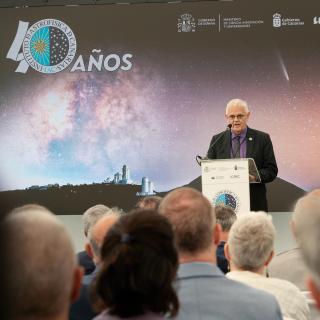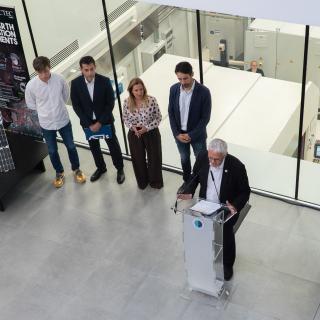“Cosmology and Astroparticle Physics” is the fourth chapter in a series of videos produced by the Instituto de Astrofísica de Canarias (IAC) in which the Institute explains its key areas of research. In this episode, researchers and engineers talk about two promising disciplines which aim at understanding the complete history of the Universe and the physical laws which govern it, which comprise Cosmology and Astroparticle physics.
Modern Cosmology studies the Universe as a whole, which implies the study of its properties, contents, origin, evolution and fate. In this research, cosmologists try to detect indirect traces of its origin. One of these fossil imprints is the Cosmic Microwave Background Radiation (CMB), a residue of the Big Bang, which floods the whole of space. Cosmologists are convinced that there are other tracers which could give us further information about the initial instants of the Universe. In particular, they expect to detect a specific type of signal, the primordial B-modes, which would demonstrate the existence of gravitational waves generated by the phase of accelerated expansion, which occurred during these initial instants, which is termed inflation.
Astroparticle physics is dedicated to the study of the elementary particles which arise during the most violent and extreme phenomena in the Universe. Its objective is to discover where these particles come from, and the processes which accelerate them to high energies. To carry out this research, a number of different detection methods have been developed, according to the type of particles: above all, gamma rays and cosmic rays. One of the main achievements which the researcher hope to make is the detection of “dark matter” which would be of great impact in Cosmology. The combination of the two branches of research would be definitive for the study of the so-called “zero instant”, the moment which saw the birth of our Universe, and where we hope to find the key to one of the main challenges of modern physics, the creation of a unified theory which would connect all the forces of nature into a single entity.
The IAC is one of the main research centres in these two field, not only publishing scientific results, but also developing specific instruments. The IAC is participating in the majority of international experiments in Cosmology and Astroparticle Physics. Among these it is leading the QUIJOTE experiment, which is looking for the trace of the B-modes originated in the first instants of the Universe. The IAC is also participating in setting up the new Cherenkov Telescope Array, for detecting and researching high energy gamma rays. It is also involved in the development and the scientific exploitation of the next mission of the European Space Agency (ESA), EUCLID, which will study the properties of dark energy.
Participating in the video are the reseachers Rafael Rebolo López, Ramón García López, Alberto Rubiño Martín, Ricardo Génova Santos, Marina Manganaro and Diego Tescaro, as well as the engineers Vicente Sánchez de la Rosa, Ángeles Pérez de Taoro and Roger Hoyland. The technical team which made the video comprises: Iván Jiménez Montalvo (director, scriptwriter and editor), Inés Bonet Márquez (camera and post-production), Daniel López (camera dolly y timelapse), Nayra Rodríguez Eugenio (production) y Alberto Rubiño (science advisor).
The IAC in five videos
These videos have been coordinated by the Unit of Communication and Science Culture (UC3) of the IAC, and have been funded by the Severo Ochoa Programme, which is an initiative of the Secretariat of State for Research, Development and Innovation of the Ministry of Economy and Competitivity, whose purpose is to promote research of excellence carried out in Spain in any field of science.
The videos explain, in a simple summarized way, the scientific and technological aspects of each branch of study and pick out the benefits which research in astrophysics gives to society. Each video is a mosaic of voices in which the members of the research teams combine to act as narrators blending into a single narrative. The locations are given particular importance, as the narrators are situated in places which show their day to day working environment, and which are parts of the infrastructure and services which make the IAC a centre of excellence with international prestige.
Other videos in the series:
"The IAC researches - Solar Physics"
"The IAC researches - Planetary Systems"
"The IAC researches - Galaxies"
Related press releases:
- The IAC explains its lines of research in five videos
- First showing of the video "PLANETARY SYSTEMS"
- First showing of the video "GALAXIAS"



